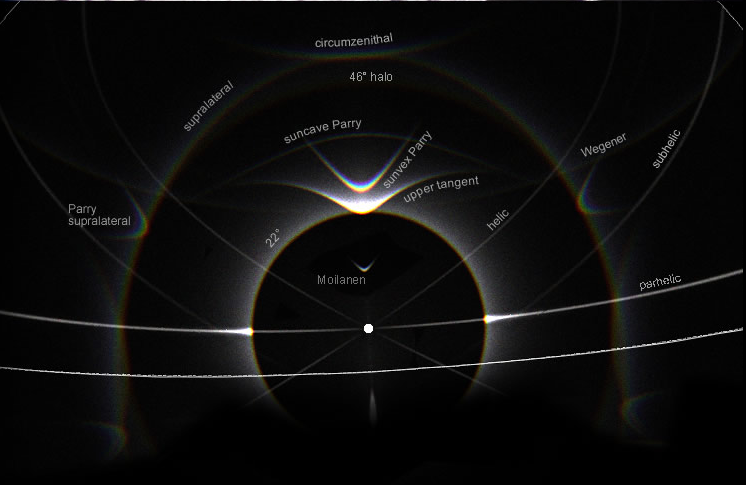Halos in a Bottle
Halos in a Bottle: Unveiling the Secrets of Atmospheric Optics
When it comes to studying atmospheric optics, natural displays of halos can be both captivating and unpredictable. However, for researchers seeking a controlled environment to explore the intricacies of these optical phenomena, the use of ice crystals generated by ski-slope snow machines presents a unique opportunity. These crystals possess exceptional optical quality and create stunning halo displays. While their beauty may differ from that of natural occurrences, they offer valuable insights into halo research.
To enhance the study of these artificial halos, researchers like Marko Riikonen have devised innovative methods. By substituting the sun with a 100W halogen lamp and conducting experiments at night, Riikonen has unlocked new possibilities. Placing the lamp at a distance of 100 meters ensures reasonably parallel light, enabling more accurate observations and measurements. It's worth noting that as the halo-forming crystals move closer to the lamp, the halos become distorted and divergent, making their simulation more complex.
In order to identify and understand the various halos produced by these ice crystals, researchers employ advanced techniques such as ray tracing simulations. HaloSim, a ray tracing simulation program designed for parallel light, plays a crucial role in analyzing the stack of images captured during these experiments. By meticulously examining these images, researchers can pinpoint different types of halos and gain insights into their formation and characteristics.
Among the rare phenomena that can be observed in these artificial displays are helic (heliac) arcs and Parry supralateral (Tape) arcs. These particular halos are seldom seen in natural displays outside of Antarctica. The helic arc is formed through external reflection from crystal side faces, while the Parry supralateral arc is a remarkable display that remains largely unexplained. By studying crystal samples obtained during these controlled experiments, researchers hope to unravel the mysteries surrounding these unique halos and gain a deeper understanding of their origins.
The artificial halo displays created by ski-slope snow machines provide an excellent opportunity for researchers to study these optical phenomena against a high contrast dark background. Unlike natural displays that are observed against the backdrop of the daylight sky, the controlled environment allows for more detailed observations and measurements. This controlled setting also enables researchers to manipulate various parameters and study the effects on halo formation, shedding light on the underlying physics and intricacies of these optical phenomena.
Understanding the properties of ice crystals and their role in halo formation is crucial for advancing our knowledge of atmospheric optics. The use of ski-slope snow machines to generate ice crystals provides researchers with a controlled platform to explore the behavior of these crystals and the halos they produce. By carefully examining crystal samples collected during these experiments, scientists can uncover valuable information about the composition, structure, and optical properties of these ice crystals. This knowledge contributes to our understanding of natural halo displays and aids in the development of accurate simulations and models.
In conclusion, studying halos in a controlled environment using ice crystals generated by ski-slope snow machines offers researchers a unique opportunity to delve into the intricacies of atmospheric optics. By replacing the sun with a halogen lamp and conducting experiments at night, researchers like Marko Riikonen have been able to shed light on rare and fascinating halo phenomena. Through advanced techniques such as ray tracing simulations and analysis of crystal samples, scientists are unraveling the secrets behind these optical marvels, deepening our understanding of atmospheric optics and paving the way for further research in this captivating field.

Halogen Lamp Halos generated by Marko Riikonen (site) November 5, 2008 at Rovaniemi, Finland. Image ©Marko Riikonen, shown with permission.
Ice crystals of high optical quality (rather than snow crystals) can grow downwind of ski-slope snow machines to give outstanding halo displays. They have a different magic to the unexpected, unpredictable and ephemeral beauty of natural displays but are excellent for halo research. However, they still depend on the whims of sunlight and their rare and exquisite quality arcs would be better studied against a high contrast dark background instead of the daylight sky.
Here, halo researcher Marko Riikonen has replaced the sun with a 100W halogen lamp shining at night. The lamp was 100m distant to get reasonably parallel light. The closer the halo forming crystals are to the lamp the more the halos are distorted and divergent light halos are much more complicated to simulate than those from parallel light.
The HaloSim ray tracing simulation, for parallel light, identifies the halos in the stack of five individual images.
Rarities are helic (heliac) arcs formed by external reflection from crystal side faces and the Parry supralateral (Tape) arcs. Both halos are almost never seen in natural displays outside of Antarctica . The rare and unexplained Moilanen arc is resolved into the glints of nearby crystals. Crystal samples taken during displays like this should eventually tell us more about this and other arcs.

Note: this article has been automatically converted from the old site and may not appear as intended. You can find the original article here.
Reference Atmospheric Optics
If you use any of the definitions, information, or data presented on Atmospheric Optics, please copy the link or reference below to properly credit us as the reference source. Thank you!
-
<a href="https://atoptics.co.uk/blog/halos-in-a-bottle/">Halos in a Bottle</a>
-
"Halos in a Bottle". Atmospheric Optics. Accessed on April 25, 2024. https://atoptics.co.uk/blog/halos-in-a-bottle/.
-
"Halos in a Bottle". Atmospheric Optics, https://atoptics.co.uk/blog/halos-in-a-bottle/. Accessed 25 April, 2024
-
Halos in a Bottle. Atmospheric Optics. Retrieved from https://atoptics.co.uk/blog/halos-in-a-bottle/.